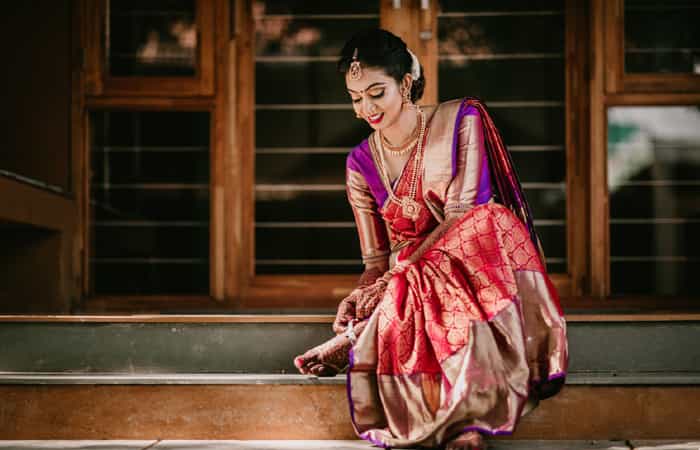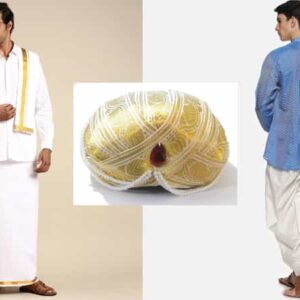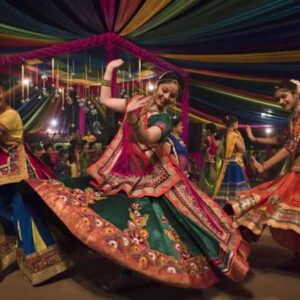Traditional apparels of women in India make a fundamental element of the Indian culture. These traditional dresses are timeless and evergreen. There is a wide range of traditional dresses for women and these dresses haven’t lost their charm despite all the changes that are coming into the ethnic style trends. If you are a true Indian from the core of your heart, you’ll definitely have a fondness for traditional Indian garments.
The culture and customs of India are reflected beautifully through the many traditional dresses that an Indian woman loves to dress up in. These dresses aptly showcase the femininity and modesty that an Indian woman is known for. The traditional dresses for women in India are blended marvelously with the unique threads and fabrics that depict the country’s cultural heritage.
Trained artisans played a pivotal role in upholding as well as maintaining the craft of designing traditional Indian dresses. Artisans in India excel in crafting some really wonderful masterpieces in terms of clothing for women. These attires are delicate, expensive and truly marvelous. So, you need to take the best care of these traditional Indian dresses for women. Here are some helpful tips:
- Instead of giving these attires a heavy and harsh wash follow the technique of dry cleaning
- Be careful regarding machine washing. Embellished traditional dresses should never be machine washed.
- Never squeeze a traditional outfit. That may destroy the clothing’s texture.
- Never leave any traditional garment hanging for long. That might lead to the garment losing its shape.
- Removing stains from traditional wear is a tricky thing. You should not leave the stain for long on the fabric as that might cause the stain to become permanent.
- Dark and dry cupboards are the best for storing costly traditional wears. It is best to use zipper bags made of plastic for storing these dresses.
Given below are some of the most important and famous traditional dresses for women in India:
Saree

Saree is one of the most important attires of the Indian woman. It can rightly be regarded as a prominent cultural icon. It is one of the oldest kinds of culture-specific apparels that Indian women have been wearing since many decades. The history of the saree as a clothing may be traced back to the period of the Indus Valley Civilization. Nearly 75% of the women in India wear a saree as their everyday garment. It is a piece of unstitched cloth stretching to a length of about 4-9 meters in length. Saree can be draped around a woman’s body in various ways.
One of the commonest and standard methods of wearing the saree is draping one end of the cloth around the woman’s waist while the other end is made to pass across the middle of the chest diagonally letting it fall over the shoulder as ‘pallu’. In some of Indian states, the saree is worn with the pallu in front. Saree, as a clothing’ hasn’t undergone much evolution over the years. However, in terms of weaving styles, embellishments, patterns, fabric and designs, changes have definitely occurred. Modern-day sarees come in a wide range of varieties. Hence, when you go to pick one you’ll really be spoilt for choice. This saree is worn along with a blouse which is but a fitted top. A petticoat which is a kind of undergarment styled like a skirt is worn underneath the saree. Sarees come in several patterns and types.
Some of the most famed saree types in India include Banarasi silk saree, Paithani Sarees, Patola Sarees, Tussar Silk Sarees, Bandhani Sarees, Leheriya Sarees, Kanjeevaram Sarees, Kasavu sarees, Chanderi Sarees, Bengal Tant Sarees, Ikat Sarees, Gadwal Sarees, Chikankari Sarees, Organza Sarees, Net Sarees and many more. Any of these sarees can be draped during special occasions to make you look truly splendid. You shouldn’t forget to accessorize your saree look with matching bangles, Necklace and earrings.
Salwar Kameez
Salwar Kameez is wondrously decent attire also known differently as the Punjabi suit. It is a highly popular Indian apparel for women. The Pathans from Kabul had brought the concept of this dress to South Asia. It is actually a set of two types of apparels- one for the upper body & another for the lower half. The Kameez is for the upper body, whereas the salwar is for the lower body. The long tunic with slits on both sides is the Kameez. The slits start from below one’s waistline. The salwar is a loose-fitting pajama. It covers the woman’s legs. The top of the Pyajama is broad and baggy while the lower part gradually narrows downward. It is pleated at one’s waist. An elastic or drawstring holds the salwar at the waist.
A dupatta or veil is used along with the salwar-kameez to complete the look and add a graceful touch to the attire. In the present times, this attire has undergone many changes in cuts, shapes, patterns and styles. These days we have different variations to the standard shalwar-kameez.
Things like Patiala suits, Churidar suits, dhoti suits, trouser suits, Anarkali suits, sharara suits and the Palazzo suits have come up. Please learn about the different varieties below:
- Patiala Suit – The salwar of the Patiala suits resembles the standard form of a salwar with lots of extra pleats. The Kameez in the case of the Patiala suit is typically short.
- Churidar Suit – The Churidar is a kind of trouser with an extended length towards the bottom. The lower part of the Churidar is arranged in the form of multiple churis or bangles.
- Dhoti Suit – The dhoti suit consists of a pajama styled like a dhoti worn by the menfolk. This suit is extremely convenient to wear. The Kameez paired with the dhoti suit is usually short.
- Trouser Suit – The trouser suit consists of tight-fitting pants.
- Anarkali Suit – The Anarkali suit features a flared and pretty long kameez reaching down almost to the floor. The upper part of the kameez is body hugging while the flares start from the waistline. This traditional wear gives the woman a royal look. The style of the Anarkali suit has actually emerged from the Mughal eras and in the present times; it is one of the most coveted clothing for the Indian woman. It comes in both heavy and lighter versions.
- Sharara Suit – The evergreen Sharara suit consists of a short kameez paired with typical wide-legged, flared pants.
- Palazzo Suit – Palazzo suit consists of a long Kameez/Kurti along with loose-fitting and broad kind of pants. Add an ethnicity to your getup with the exquisite palazzo suit.
Lehenga-Choli
This beautiful traditional dress comes in a vast array of styles and designs. In northern India, this dress is especially a fond choice. In the states like Gujarat, Rajasthan, Uttar Pradesh and Madhya Pradesh this attire is widely used during the festivals. It is also referred to as Ghagra-Choli. The lehenga or ghagra is like an embellished skirt that’s beautifully pleated. The fabric used for making the lehengas is generally a heavy kind of fabric. Choli is the blouse that’s used to clad the upper half. The choli is fitted tightly at the woman’s waist. It’s similar to the one that’s worn along with the apparel called a saree. A dupatta is carried along with the Lehenga & Choli. The dupatta also called Chunri is a versatile covering and can be arranged on the woman’s body in several ways.
It can be placed over one’s shoulder or can be tucked beautifully into the lehenga or can be wrapped around one’s waist or can be placed over one’s neck. The dupatta usually comes with a lace border. The lehenga-choli-dupatta ensemble is ideal for all fancy occasions but many women in India prefer to wear it on their wedding day. So, Lehenga-Choli is the traditional wedding attire for women in India. The Lehenga-choli style hasn’t much evolved across the years except for the dupatta draping pattern and the fabric used. In the state of Gujarat wearing the Lehenga-Choli is a must, especially during the festivals of Garba and Navratri. Women make sure to don this traditional attire as the participate in the dandiya dance.
Gown
Ethnic gowns are much loved by a woman. This is traditional attire that comes with a modern twist. This flowy, floor-length dress comes in delicate fabric and royal designs. For any festive occasion or grand wedding Parties, this dress is simply ideal. It is available in wide range of fabric options such as crepe, velvet, chiffon, silk, georgette and more.
Gotta Patti Kurti
Kurti is a tunic-type garment that comes in various lengths, fabrics and styles. Kurti showcasing the famous Gotta Patti work of Rajasthan is a beautiful traditional apparel loved by the Indian woman. Gotta Patti embroidery is done most painstakingly by the craftsmen of Rajasthan. The work is done using gold or silver yarn and the Kurti featuring the Gotta Patti work looks really gorgeous. You can flaunt these beautiful Kurtis on any kind of special occasion. They are sure to add an ethnic touch to your getup.
Long Skirt
Long skirts paired with tops can give you a cool look. You can sport long skirts for casual occasions. Embellished ones can be worn during festivities and parties. You can also wear these skirts with short and long Kurtis. Long skirts featuring the Leheriya print or the Jaipuri print are exceptionally popular with an Indian women. Showcase your allure and look utterly fashionable wearing a long skirt. Chunky jewelries go very well with a long skirt and crop top. Carrying a stole will simply complete your getup.
Ethnic Shrug
Revolutionize your ordinary attire by topping it with an ethnic shrug. Ethnic shrugs can completely transform your commonplace look. Shrugs may come with embroideries or may have other embellishments like beadwork, glasswork, sequin work, applique work, etc. The type of shrug you opt for much depends on the type of garment you choose to wear underneath. Shrugs could be long or short. Long shrugs are generally knee-length while short shrugs are up to the waistline. Shrugs can update your look most beautiful. You can wear shrugs with Dhoti Salwar Suit, medium-length Kurtis, short tops, long skirts, and more.
Pheran
Women love to sport beautifully embroidered Pheran/Phiran. This dress has originated in Kashmir but now it is used all over the country. It is actually loose-fitting clothing for the upper body. It has pretty wide sleeves. The Pherans are crafted out of Jamewar or wool and exhibit beautiful Kashmiri embroidery. Pherans are usually brightly colored and are worn by women in the winter month. Pherans are mostly worn over some kind of under-clothing. For the bottoms, salwar, churidar or leggings can be worn.
Langa-Davani
In Southern India especially this dress is widely worn by young girls. However, these days fashion designers of the country have popularized this garment and so, in other parts of the country too women have started wearing this dress. Another name for this dress is Pattu Pavadai. There are 3 pieces to this apparel- a skirt, a top and the Voni also differently referred to as the Davani or oni. The Voni is artfully wrapped over the top and is nearly 2.5 meters long. The dress is somewhat similar to the north Indian Ghagra-Choli and comes in dynamic colors. The dress features contrasting borders, geometrical patterns, and other temple-themed patterns. The fabrics used to craft the Langa-Davani include Kanchipuram Silk, Pochampally Pattu, Dharmavaram Pattu, Banarasi Silk, Lkat Silk, Coimbatore Silk, Kasavu Pavadai, Chettinadu cotton and handloom cotton.
In the various South Indian states like Tamil Nadu, Kerala, Karnataka, and Andhra Pradesh this dress is worn during festivals and is known by different names in different states. In Andhra Pradesh, it is called Langavoni. In Tamil Nadu, it is called Pattu Pavadai. In Karnataka, it is called Langa Davani.
So, these are some of the traditional Indian wardrobe staples for women. Pick any of these items to add to your Indian apparel wardrobe. Explore the eclectic options you have to stand out from the crowd!



